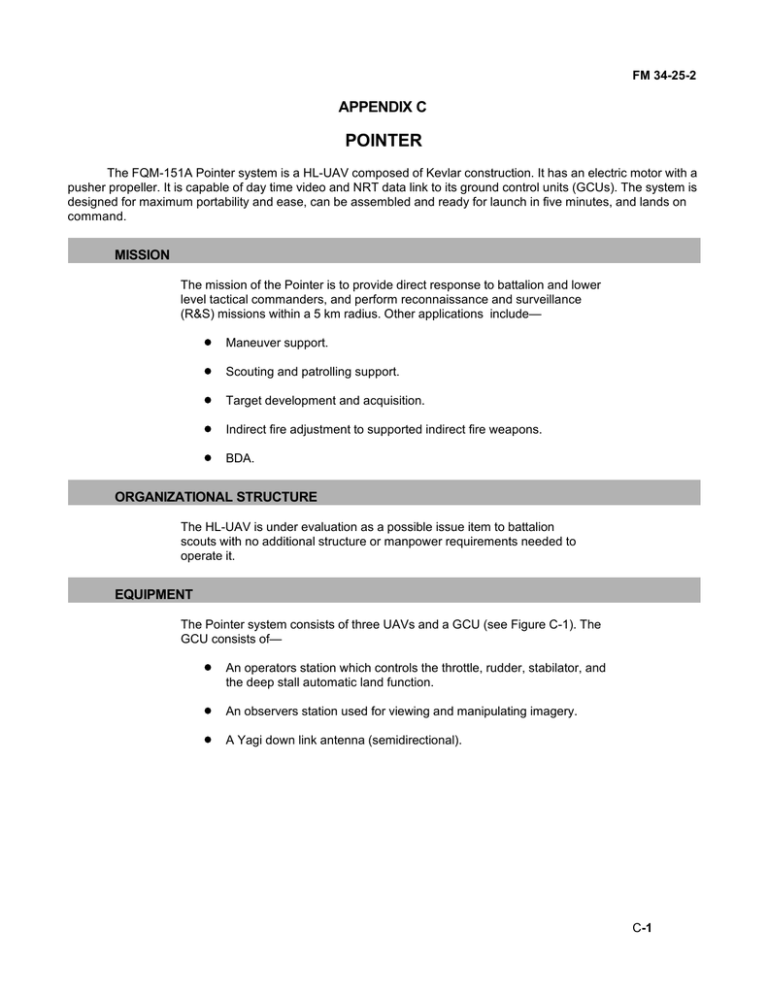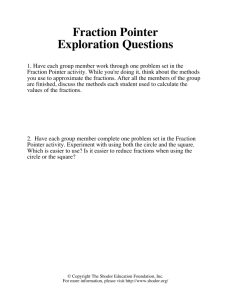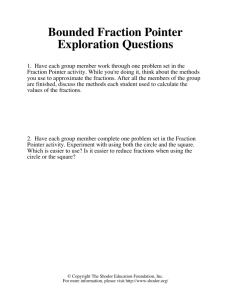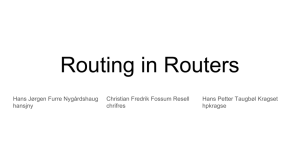POINTER APPENDIX C
advertisement

FM 34-25-2 APPENDIX C POINTER The FQM-151A Pointer system is a HL-UAV composed of Kevlar construction. It has an electric motor with a pusher propeller. It is capable of day time video and NRT data link to its ground control units (GCUs). The system is designed for maximum portability and ease, can be assembled and ready for launch in five minutes, and lands on command. MISSION The mission of the Pointer is to provide direct response to battalion and lower level tactical commanders, and perform reconnaissance and surveillance (R&S) missions within a 5 km radius. Other applications include— Maneuver support. Scouting and patrolling support. Target development and acquisition. Indirect fire adjustment to supported indirect fire weapons. BDA. ORGANIZATIONAL STRUCTURE The HL-UAV is under evaluation as a possible issue item to battalion scouts with no additional structure or manpower requirements needed to operate it. EQUIPMENT The Pointer system consists of three UAVs and a GCU (see Figure C-1). The GCU consists of— An operators station which controls the throttle, rudder, stabilator, and the deep stall automatic land function. An observers station used for viewing and manipulating imagery. A Yagi down link antenna (semidirectional). C-1 FM 34-25-2 CAPABILITIES The Pointer system has the following capabilities: Mission payload. . . . . . . . . . . . . . . . .8 mm daytime video recorder and down link. Look down angle . . . . . . . . . . . . . . . . . . . . . . . . . 22o or 30o. endurance Range and . . . . . . . . . . ..5 km with a 1-hr flight time. Video includes . . . . . . . . . GPS locational data, AV heading, altitude, revolutions per minute (rpm), and elapsed time. C-2 FM 34-25-2 Communications . . . . . . . . . . . . . . . . . Organic comms net. Planned integration into digitized battlefield comms and data net. Operational attitude . . . . . . . . . . . . . . . . . . . . 200 to 500 ft. Powerplant 300 W electric motor. Power source . . . . . . . . . . . 2 lithium batteries or 2 Ni-Cd. Wingspan 2.7 m (9 ft) assembled. Length 1.8 m (6 ft) assembled. Weight 4 kgs (9 lbs) assembled. Mission payload . . . . . . . . . . . . . . . . . . 8 mm video recorder. LIMITATIONS The Pointer system has the following limitations: Wind 15 kts or less. Weather Heavy rain or snow, or thick fog. AIRSPACE MANAGEMENT IN SUPPORT OF MILITARY OPERATIONS The airspace management of the HL-UAV is accomplished through the use of ROZs, as outlined in Chapter 3. The standard HL-UAV ROZ dimensions are 5 km x 5 km x 500 feet AGL (see Figure C-2). The standard ROZ can be either preplanned or immediate. Preplanned. Preplanned ROZs are strategically placed to support present or future operations; for example, along the avenue of advance for an offensive operation. Preplanned ROZs can be requested in sufficient time to be included in the ATO, and activated or deactivated as needed. Immediate ROZs are requested whenever the Pointer must fly outside of the preplanned ROZs. Immediate. Immediate ROZs are requested through A2C2 channels to the approving authority and the subsequent approval or disapproval is sent back down. Once approved, the scouts notify the same A2C2 channels of takeoff and landing times. C-3 FM 34-25-2 C-4 FM 34-25-2 NATIONAL AIRSPACE SYSTEM The airspace management in the NAS differs from that in support of military operations as outlined in Chapter 3. The HL-UAV must follow all FAA regulations and ARs that apply to UAV's classified as model aircraft—no chase planes required. NOTE: If the operator has the means of maintaining an altitude of 1,000 feet or less, either through training or the addition of an altimeter, the HL-UAV would be classified as a model airplane and thus require no coordination to fly in the NAS. OPERATIONS The scouts will set up and operate the HL-UAV primarily while in the defense (see Figure C-3). The imagery is reviewed by the scouts and a SPOT Report is sent via normal reporting channels. The tactics of employing the HL-UAV are outlined in FM 17-98, but do not include all TTPs. C-5 FM 34-25-2 Figure C-3. Full C-6





